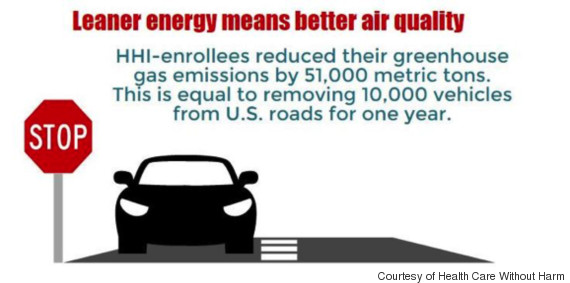
In just two years, Boston's health care sector has cut its energy use by 6 percent to help reduce the causes that lead to climate change.
In the nonprofit world, we are constantly pushed to quantify our success. The bigger the numbers, the more funding, prestige and visibility come our way. As a result, planning and strategizing are often driven by hard, measurable outcomes. But the numbers alone paint an incomplete story of our work, of our value.
It's not that the numbers don't matter, they are just one piece of the puzzle. The question we have to ask ourselves is how do we build a connection between our quantifiable metrics and the big-picture social impact we set out to achieve?
At Health Care Without Harm, we ask big questions. Given the health care sector's moral mission and massive buying power, how can the sector shift our entire economy toward sustainable, safer products and practices? Seeking to answer questions like this, we collect a lot of data on hospitals around the world on things like energy reduction, waste management and healthy food. In its aggregate, this information can show momentum within the entire health sector around sustainability and environmental health. But what do those numbers mean? Why are they important? How do they push our agenda forward? Without context, the significance of all that data collection can get lost.
Take the Boston Green Ribbon Commission for example. The Commission is a group of businesses, institutions and civic leaders developing shared strategies for fighting climate change in coordination with the city's Climate Action Plan. The Plan itself includes strong recommendations on how Bostonians can increase efficiencies, reduce emissions, and prepare for extreme weather and higher sea levels. The Commission is working to achieve the Plan's goal of a 25 percent reduction in greenhouse gas emissions by 2020, and an 80 percent reduction by 2050.
Driven by health sector leadership and supported by a long-term commitment to data collection, the Boston Green Ribbon Commission has enjoyed significant success. Virtually all of the major Boston hospitals -- encompassing over 65 buildings with 24 million square feet of owned space -- have entered energy data for multiple years into EPAs Energy Star Portfolio Manager. The result of these efforts is a first-in-the-nation health care metropolitan area energy and greenhouse gas data set. In just two years, the health care sector cut its energy use by 6 percent compared to business as usual, greenhouse gas reductions for all fuels equaled 14,286 MtCO2e, and cost savings are estimated at $12 million.
Are those numbers and figures impressive? According to the Energy Star Portfolio Manager they are. But without any context, why are the numbers important?
To put it into perspective, the achieved energy reductions are the same as eliminating the annual greenhouse gas emissions of 7486 cars. If you've ever experienced Boston traffic, you could imagine what a reduction like that would look like. Or consider that $12 million in savings from improved energy efficiency is enough to pay for healthcare for 1055 Massachusetts Medicare enrollees. Suddenly, the numbers tell a story.
With nearly 1000 participating hospitals, Healthier Hospitals is a nationwide health care sustainability effort driven by big data. Hospitals commit to one or more of six proven strategies or "challenge" areas to improve their sustainability performance. Since 2010, participating hospitals have recycled the weight equivalent of 45,000 garbage trucks (nearly 446,000 tons). More than $70 million was spent on local and / or sustainable foods. In the past three years, around $175 million was spent on reprocessed single-use devices.

This graphic was created as part of the Healthier Hospitals 2013 Milestone Report release, and demonstrates a quantitative metric through a social impact conversion (cars off the road annually).
Individually these hospitals are taking important and sometimes difficult-to-implement steps to provide healthier facilities for their patients and staff. When added up, these numbers represent the collective, front-line leadership within the health care sector to build healthy, sustainable communities across the country. In this aggregated data lives the story of the "time, experience, wisdom, creativity, and perseverance" of thousands of individuals committed to seeing a healthier future.
Big data is a funny thing. On one hand, it represents the aggregate of a bunch of similar actions. But without context, the power of those numbers is lost. It's not the data itself that drives strategy or funding. It's the implications of that data -- the story the data is telling -- that determine decisions.
We work really hard to cultivate a healthier, more sustainable future and every day we make decisions based on the data we have. But the questions behind those decisions are just as important. Why? Why does it matter? Why should we change? With the right context, big data can help us answer the most important question of all: Why should we care?
Health Care Without Harm is a partner of Cisco CSR. Cisco sponsors The Huffington Post's ImpactX section.